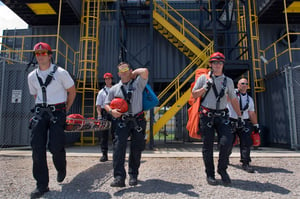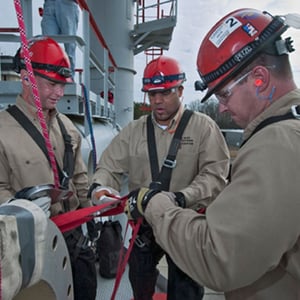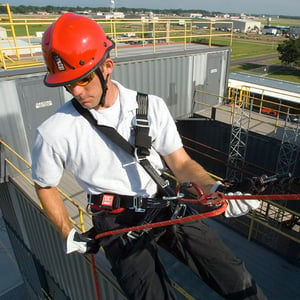 This topic was brought to light by one of our blog participants. Since it may affect many industrial rescue teams in our readership, we are posting the information here to share with the entire community.
This topic was brought to light by one of our blog participants. Since it may affect many industrial rescue teams in our readership, we are posting the information here to share with the entire community.
In response to a question about manpower requirements for stand-by rescue teams (How many members should be on a standby team?), the Roco Tech Panel has gathered some information which we hope will be helpful. First of all, we will address it from a regulations and standards prospective, and then offer some considerations and practical guidelines that we use here at Roco.
Of course, your company’s internal policy and safety procedures must always be considered first.
OSHA’s Permit Required Confined Space Regulation (1910.146) is our primary reference for this topic; and, as mentioned, it does not state the specific number of personnel required for stand-by operations. This standard is intended to be “performance based” and a determination of the prospective rescue service’s ability to perform rescue from the types of spaces which they may respond is to be evaluated by the employer. If the evaluated team, regardless of number, can safely and effectively perform rescue from the applicable spaces in a timely manner, then the team would be deemed capable.
However, we must also use a degree of judgment and take into consideration all the particulars of the types of spaces that may be encountered and the types of injuries that the entrants may incur – which will dictate the type of patient packaging that may or may not be required inside the space. All the factors, such as twists and turns into and out of the space, communications, placement of directionals, and intermediate anchors and haul/lowering systems should all be considered factors in determining the size of the rescue team. As an example, rescuing an entrant from a 24-inch round horizontal portal that is 3-feet off the ground would require a minimum of personnel. But, take this same scenario to 80-feet off the ground, or an on-air IDLH event, and it’s a much different story!
 Next, the Respiratory Standard (1910.134), section (g)(3)(i) states that “One employee or, when needed, more than one employee is located outside the IDLH atmosphere;” and Section (g)(3)(iii) adds that…“The employee(s) located outside the IDLH atmosphere are trained and equipped to provide effective emergency rescue” – however, we are given no set number of personnel.
Next, the Respiratory Standard (1910.134), section (g)(3)(i) states that “One employee or, when needed, more than one employee is located outside the IDLH atmosphere;” and Section (g)(3)(iii) adds that…“The employee(s) located outside the IDLH atmosphere are trained and equipped to provide effective emergency rescue” – however, we are given no set number of personnel.
Sometimes we hear the HAZWOPER standard (1910.120) cited regarding IDLH response requirements. This standard requires the use of the “buddy system with stand-by personnel” for emergency response operations involving the release of hazardous substances producing IDLH conditions for employees responding. This regulation specifies a minimum of four personnel, two as a team in the buddy system and two stand-by personnel, to conduct operations in hazardous areas safely. Again, however, this is from the HAZWOPER regulation.
From the National Fire Protection Association, NFPA 1670 (Standard on Operations and Training for Technical Search and Rescue Incidents) states that six (6) rescue technicians shall be the minimum staffing for a “Technician Level” confined space response. This typically means any IDLH condition (breathing air; complexity; elevated or entanglement concerns) that exists in a permit required confined space rescue operation.
Now, we’ll give you an idea of how we address this at Roco with our stand-by rescue services. First of all, our typical (standard) Confined Space Rescue Team is made up of three persons including a Crew Chief and two Rescue Technicians. Keep in mind, that these are experienced, professional emergency responders, who perform stand-by rescue operations and/or train on a regular, if not daily, basis. In addition, the job circumstances and scope of work are carefully evaluated prior to committing a specific number of personnel. As a example, here are some basic guidelines:
Four-person team (minimum) for jobs involving inert entries, other types of IDLH entries, unusual space configurations (i.e., long distances, underground piping or complex obstructions.) As mentioned above, a three-person team made up of experienced rescuers is our standard operational manning requirement. This applies to the majority of our stand-by rescue work. In certain instances, a two-person team may be appropriate. For example, when there is very low potential for atmospheric hazards; large and easily assessable manways; no secondary lowering operations required; strictly horizontal movement, etc.
In closing, we must re-emphasize that OSHA 1910.146 is a performance-based standard that requires safe, timely and capable rescue response for confined space incidents. A realistic, hands-on rescue performance evaluation as referenced in Appendix F of this regulation can be a valuable tool in determining training, equipment and personnel needs based on the circumstances in your response area.
We hope this information has been helpful. Roco Rescue Online and the information herein is provided as a complimentary service for rescuers and emergency response personnel. As always, proper training is required prior to use of any technique described. If we may be of further assistance, please don’t hesitate to contact us at Roco headquarters by calling, 1-800-647-7626.


 Our thoughts and prayers go to the people of Japan as well as the many incredible personnel involved in the rescue and recovery efforts. Sharon Bulova, Chairman of the Fairfax County Board of Supervisors, provided this update on VA Task Force 1, who was deployed to Japan a few days ago.
Our thoughts and prayers go to the people of Japan as well as the many incredible personnel involved in the rescue and recovery efforts. Sharon Bulova, Chairman of the Fairfax County Board of Supervisors, provided this update on VA Task Force 1, who was deployed to Japan a few days ago.  Our team and other international rescue teams are under the command of local first responders, in our case the Osaka Fire Department, so many of whom have lost so much. Despite the overwhelming devastation that surrounds them, these brave souls have chosen to lead teams of visitors into the wreckage that was once their homes, their schools and their neighborhoods, and search for signs of life in a sea of destruction.
Our team and other international rescue teams are under the command of local first responders, in our case the Osaka Fire Department, so many of whom have lost so much. Despite the overwhelming devastation that surrounds them, these brave souls have chosen to lead teams of visitors into the wreckage that was once their homes, their schools and their neighborhoods, and search for signs of life in a sea of destruction.

 We get many calls asking about the “life expectancy” of rope, harnesses and other nylon products. Of course, there are many factors involved and no one “set in stone” answer, but a lot depends on how much you use your harness and the ways you use it. Even where you store your gear is a factor.
We get many calls asking about the “life expectancy” of rope, harnesses and other nylon products. Of course, there are many factors involved and no one “set in stone” answer, but a lot depends on how much you use your harness and the ways you use it. Even where you store your gear is a factor. 




